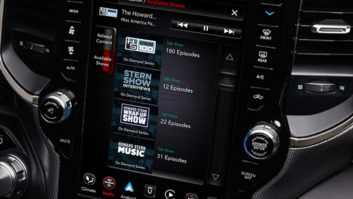An ‘Elementary’ Examination of Satellite Radio’s Prospects
Many readers will recall from high-school physics that one of the metric system’s references for the standardized length of a meter was a rod of platinum-iridium alloy.
Those two metals provide a different kind of metric for today’s media industry, however. Platinum is the mark of success for a music release, signifying a million-selling title, while Iridium is now associated with Motorola’s notoriously failed satellite telephone system – the Edsel of low-earth orbit. The two elements once paired in a harmonious definition are now diametrically opposed in their connotations.
Such are the polar opposites that exist as possible fates for satellite radio. Within the next few years, the success or failure of this bold new enterprise will be determined. There will likely be no intermediate option.
Will satellite radio become No. 1 with a bullet, or a just another contribution to the growing collection of space junk? Interestingly, we are now in a period of absolute equilibrium between the two extremes, in which either outcome seems equally plausible. Momentum in one direction or the other has not yet been clearly established.
This blissful state will likely not last for long.
Early returns
Aftermarket XM Satellite Radio receivers are now widely available at consumer electronics retail outlets in most areas of the United States, and factory-installed units will be offered in some 2002 model-year vehicles in upcoming months. Many more carmakers will offer the receivers in 2003 models.
Gauged by the rule that it’s not real until consumers can buy it, satellite radio now is clearly a genuine article.
It is to XM’s credit that it was first to market, given the general sense that the competing service, Sirius Satellite Radio, was further along in its development up until about a year ago. Also, XM’s use of geostationary satellites, as opposed to the highly elliptical orbit system used by Sirius, has a greater reliance on terrestrial repeaters, so XM needed to establish a large, reliable network of these repeaters before launching their service. So far, no significant complaints about signal coverage have been reported.
While satellite radio wasn’t the must-have gift for the 2001 holiday season, it received reasonably high profiles in stores and the press, and most reviews have been moderately to strongly positive. Fortune magazine named XM its “Product of the Year” for 2001, and Time and Popular Science both featured XM among their top new technologies of 2001.
The initial commercial inertia faced by any new product seems to be dissipating, based purely on XM’s marketing efforts so far. One can only assume that when Sirius joins the fray later this year that satellite radio’s incipient momentum will build further.
Staying power
Of course, the real metric of success for satellite radio will be the size and growth rate of the subscriber base.
In this respect, the new service is less like terrestrial radio and more like cable or satellite TV. Users must be convinced to buy new hardware and pay a monthly service fee. It’s the latter element that crosses into new territory.
Will consumers buy radio service – and will they keep buying it indefinitely? The scourge of any subscription service is churn, by which the service’s growth is partially cancelled out by the departure of existing subscribers who no longer find the service sufficiently valuable. The initial deal of “100 channels for $9.95 per month” soon fades to the five or six channels any consumer ends up using for that monthly price, and the value is soon recalculated.
For some, it will remain worthwhile, but probably not for all. This is likely the greatest unknown that satellite radio faces, and the most pivotal issue to the ultimate success or failure of these services.
One way to minimize churn is to offer only long-term subscriptions, or for factory-installed mobile systems, to include a long-term service contract in the purchase price of the vehicle. Another method is to make the cost of the receiver high enough to make the owner feel guilty about not keeping the subscription going, but not too high to be prohibitive to getting the service in the first place.
The latter effect is called “skin in the game,” by which the consumer feels like an investment has been made in the hardware purchase, and its value would be wasted if the service subscription were not kept up. (A similar function is served by the initiation fee at a health club.)
Some validating experience comes from the satellite TV environment, where DIRECTV offered hardware that had to be purchased, and (the now defunct) Primestar provided the hardware free. Primestar’s churn rate typically was about double that of DIRECTV’s.
XM’s approach is mixed in this respect. Aftermarket receivers are priced about $500 installed, to start, which seems about right for the purpose, but month-to-month service is offered. (It’s unknown if service contracts will be structured any differently for factory-installed systems, when they become available.)
Also, one area where XM has taken some heat in the press is its requirement for multiple radios within one household to each pay the same, full service fee. There is currently no “family plan” or multi-receiver discount offered.
For satellite radio to succeed, subscriber base growth targets will have to be hit and maintained, even in the early years. Although the bulk of any DBS service’s investment is front-loaded, satellites are not immortal. They have a finite lifespan (shorter than originally forecast, in this case), and contracts for their replacements’ construction and launch will have to be drawn years in advance of this date.
This means that decisions on the second generation of satellites will hinge substantially on satellite radio’s performance in its first five years or so. New funding for satellite radio is still forthcoming from investors – no mean feat in today’s economic environment – but this can change quickly if bad news circulates.
The road ahead
Another unique element of satellite radio is the addressability of receivers. While this is primarily required for controlling and enforcing conditional access to subscription content, it also could eventually figure in satellite radio’s business model in other ways.
For example, personalized messaging or other custom content could be delivered to individual receivers at a premium price. Or targeted commercials could be delivered to specific receivers, providing a new paradigm of access for advertisers to certain desirable demographic groups nationwide.
Recently a tempest has brewed over the possibility of satellite radio providers finding loopholes in the rules for the content carried by terrestrial repeaters. Traditional radio broadcasters are concerned that local content (i.e., advertisements) will be downloaded to individual satellite radio repeaters and inserted into programming. They feel this violates the spirit of the original regulation for the service, which prohibited carrying anything other than an exact duplication of the satellite signal on terrestrial repeaters, for purposes of technical signal-coverage improvement only.
In comments filed by the NAB, the FCC has been asked to tighten the regulatory language governing the content carried on these repeaters, and also to deny satellite radio’s requests for increased maximum power levels on the repeaters.
Many open issues will be settled by the marketplace in coming months. The stakes are high, and fortunes of a significant new medium hang in the balance. Only time will determine whether satellite radio will splash or soar.












